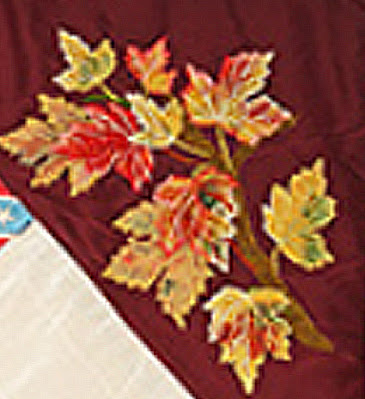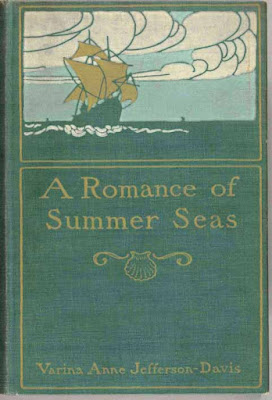Varina Davis with her namesake Varina Anne "Winnie" (1864-1898) at the end of the Civil War. Winnie was great consolation to her mother who did not get to spend much time with her once the Confederate cause was lost.
One of the stories that didn't fit into my book Divided Hearts: A Civil War Friendship Quilt is the tale of Winnie Davis whose romance was victim of the North/South divide---but decades after the war was over.
Winnie's sisters and brothers went into Canadian exile cared for by their grandmother Margaret Kempe Howell and the baby joined them there.
Once their father was released from jail the family fled to Europe. Winnie spent her younger years in a German boarding school, returning to the United States in the early 1880s as a 17-year-old who'd grown up abroad.
Winnie was glad to become her father's companion and help meet, joining him in his travels to promote his book, unveil monuments and give speeches at reunions. In the mid-1880s publicists for the Southern image dubbed the girl who grew up in Europe as "The Daughter of the Confederacy" a role she seemed glad to take on.
In 1886 she visited family friends in New York and met Alfred Wilkinson, a Syracuse patent lawyer They fell in love and became secretly engaged.
In 1889 Wilkinson visited Winnie's parents in Mississippi to ask for her hand. Mother Varina approved.
Father Jefferson told her he felt her "death would be preferable." For himself death came soon in December, 1889 while Winnie was back in Paris, followed by Fred who persuaded her the time was right to announce their engagement. When they returned to America in summer, 1890 they were shocked to find the hatred their love inspired among obsessive Southerners like Jubal Early, the "Watchdog of the Confederacy."
The Daughter of the Confederacy submitted to her public image and her late father's wishes, breaking the engagement "due to ill health." Again the press was unmerciful bringing up Alfred's recent business losses and Winnie's imaginary engagement to a more suitable Southerner.
Winnie moved with her mother to New York City but she never saw Fred again. Neither of them ever married.
Joan E Cashin's First Lady of the Confederacy: Varina Davis
Heath Hardage Lee's Winnie Davis: Daughter of the Lost Cause
Winnie and her nurse Ellen Barnes
American Civil War Museum Collection
Do a search for Winnie in their collections
and see quite a few objects.
Varina and Jefferson Davis's youngest child was born in Richmond's Confederate White House during the war's last year. After the Davises fled Richmond and her father was imprisoned Winnie and her mother accompanied him to prison at Fortress Monroe where Varina perhaps began this silk quilt.
Sere, yellowing autumn leaves. Each plant in Varina's quilt
had symbolism
Winnie's sisters and brothers went into Canadian exile cared for by their grandmother Margaret Kempe Howell and the baby joined them there.
The Davis children in Canada, a photograph sold after the war.
American Civil War Museum Collection
Sampler signed Winnie Davis
stitched at her school in Karlsrhue Germany
It is signed Winnie Dawis, a Germanic spelling.
American Civil War Museum Collection
Mother Varina Davis stitched this silk quilt recalling "The
Lost Cause" as the short-lived butterfly in the center.
Winnie was glad to become her father's companion and help meet, joining him in his travels to promote his book, unveil monuments and give speeches at reunions. In the mid-1880s publicists for the Southern image dubbed the girl who grew up in Europe as "The Daughter of the Confederacy" a role she seemed glad to take on.
Winnie Davis Cigars
She maintained a high profile in the press. A search for her name in newspapers in the last half of the century yields almost 80,000 hits. Fame came with a price, however.
In 1886 she visited family friends in New York and met Alfred Wilkinson, a Syracuse patent lawyer They fell in love and became secretly engaged.
April 1890, Sandusky, Ohio
The press North and South was vicious.
Winnie could not have fallen for a more controversial fiancé unless perhaps she'd chosen Robert Lincoln or a grandson of Union General Benjamin Butler.
Alfred's mother was Charlotte Coffin May Wilkinson, first cousin to Louisa May Alcott. Louisa's mother Abba May Alcott was quite close to her brother Samuel Joseph May and their daughters born a few weeks apart grew up as good friends. Charlotte had only brothers and Louisa signed her letters "Your sister-in-love," according to May descendant Eve LaPlante, author of Marmee & Louisa.
Charlotte's father Reverend Samuel Joseph May was an outspoken and infamous antislavery activist in the years before the Civil War. Born in Boston he became a Unitarian minister in Syracuse in 1845. Alfred was thus the grandson of one of the leading abolitionists---anathema to die-hard Confederates like his father-in-law to be.
Alfred Wilkinson known as Fred
(1858-1918)
Fred was 3 years old when the war began
Father Jefferson told her he felt her "death would be preferable." For himself death came soon in December, 1889 while Winnie was back in Paris, followed by Fred who persuaded her the time was right to announce their engagement. When they returned to America in summer, 1890 they were shocked to find the hatred their love inspired among obsessive Southerners like Jubal Early, the "Watchdog of the Confederacy."
Winnie reading a letter to her sister Margaret,
a commercial cabinet card sold in the 1890s.
Did Winnie have an eating disorder? She is quite thin.
The Daughter of the Confederacy submitted to her public image and her late father's wishes, breaking the engagement "due to ill health." Again the press was unmerciful bringing up Alfred's recent business losses and Winnie's imaginary engagement to a more suitable Southerner.
Wichita Eagle, February 1891
Winnie spent her time publishing two romance novels, joining the city's social life with trips South to ornament Confederate reunions. Biographers write of her sadness and illness in those New York years.
Her physical health deteriorated due to a mysterious illness ---described as chronic gastritis---and she died at 34 years old in September, 1898 in Rhode Island.
The single butterfly from her mother's quilt.
"The girl to country true,
May ne'er in wedlock give their hand
To those who wore the blue."
One more sacrifice for the Lost Cause.
Two relevant biographies:
Joan E Cashin's First Lady of the Confederacy: Varina Davis
Heath Hardage Lee's Winnie Davis: Daughter of the Lost Cause




















No comments:
Post a Comment